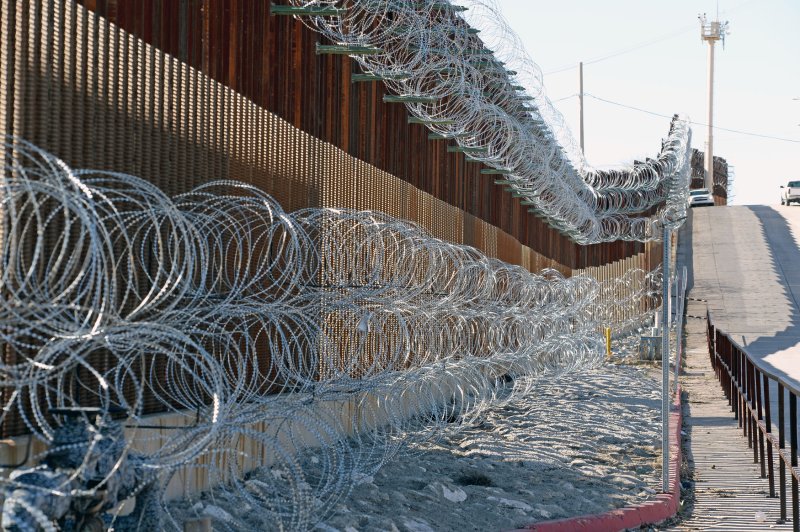1 of 3 | Environmentalists say that concertina wire like the type pictured in Nogales, Ariz., placed along the U.S.-Mexico border endangers rare wildlife like wolves and jaguars. File Photo by Art Foxall/UPI |
License Photo
MEXICO CITY, March 15 (UPI) -- Razor wire newly laid at the U.S.-Mexico border endangers gray wolves and rare jaguars because it cuts them off from food, water, shelter and mating partners, environmentalists said.
Since November, troops have laid 210 miles of the razor wire, dividing the border region to deter migrants from unlawfully entering the United States from Mexico.
"It's a decidedly effective barrier. The wire has razor sharp edges. It would stop people and animals. It's ugly that we have gotten to this point," said Montana state Sen. Mike Phillips, D-Bozeman, a conservation scientist who directs the Turner Endangered Species Fund.
Phillips has worked for more than 30 years to save the Mexican gray wolf from extinction. There are about 114 of these wolves in the wild across northern Mexico and the southwestern United States, according to the conservation nonprofit Defenders of Wildlife of Washington, D.C.
"Any barrier, wall or fence that would stop a person is going to stop a wolf. People are more resourceful than wolves. A wolf is not going to dig a tunnel," Phillips said.
"When species numbers are so low, that's when connectivity becomes really important," Phillips said. With connectivity blocked by border barriers, animals inbreed and genetic diversity suffers, threatening species survival, he said.
'What gets up doesn't get over'
Concertina razor wire is folded in a flattened coil to facilitate installation. The government variety differs from barbed wire because it has hundreds of steel razors rather than small pieces of pointed wire.
"Concertina wire enhances the effectiveness of existing barriers by providing an additional level of fortification, impedance and denial," said Kevin McAleenan, the U.S. Customs and Border Protection commissioner.
Allied Tube and Conduit of Hebron, Ohio, markets steel razor wire for military, border and prison use in its catalog with the slogan, "What gets up doesn't get over." Company labels bearing the U.S. government contract number were found last year in the lower Rio Grande Valley.
The manufacturer secured a $41 million "indefinite delivery contract" to supply the Department of Defense in 2014. It also supplies the U.S. Bureau of Prisons.
Imperiled jaguars
Jaguars are another imperiled species in the area, and their habitat straddles the border and its desert mountains. Border barriers and concertina wire affect jaguars, conservationists said, because they need to roam over vast distances for hunting and mating.
"If we are ever going to see this population recover in the United States, where they are extremely rare now, jaguars need to be able to move back and forth across the landscape," said Bryan Bird, southwest program director for conservationist nonprofit Defenders of Wildlife.
"If animals do not exchange genetic material, they go extinct," Bird said.
He added: "Any border barrier creates a death zone around it and poses a danger to people and wildlife. Wildlife are going to end up entangled in the wire, meaning more deaths. In the case of endangered wildlife, we don't have the luxury of losing even one."
Defenders of Wildlife estimates that some 80 to 120 jaguars live on the Arizona border in northern Sonora, Mexico. The organization said this Sonoran jaguar population "is the last hope for recovery in the United States."
In a call to action last summer published in the journal Bioscience, 2,700 scientists from around the world sounded the alarm over border barriers.
"What matters is whether the barrier is passable, and from a jaguar's point of view, an uncrossable fence has the same effect as a wall," the concerned scientists wrote.
No public input
Environmentalists also objected to the U.S. Army installing the wire with no public input.
It was "deployed with no coherent strategy, no regard for public safety and without a thought for the deadly harm it will inflict on wildlife," said Laiken Jordahl, borderlands campaigner with the Center for Biological Diversity in Tucson, Ariz.
"In many South Texas wildlife refuge tracts, the wire has been strung along the river or other irrigation canals, placing a potentially lethal obstruction between wildlife and their water source," Jordahl said.
The sheriff of Santa Cruz County, Ariz., Tony Estrada, said the U.S. government did not ask him about laying concertina wire at and between the three ports of entry in his jurisdiction, which cover 50 miles of the international border.
"The U.S. government has a way of doing things without letting locals know," Estrada said. "They don't consider touching base. They don't ask for opinions. They are afraid to hear we won't want wire. So they just go ahead and do it."
Hurts livestock
Ranchers often use strands of barbed wire to fence in their property and prevent livestock from roaming. Even so, some border ranchers say using razor wire is unthinkable.
"We aren't going to allow wire on our property. We'll take the government to court if they try that, too," said Rey Anzaldua, a South Texas rancher whose family has owned riverfront land on the South Texas border for 10 generations.
The Anzalduas' property abuts the Rio Grande river at the international border. The family is litigating against the government to prevent it from using eminent domain to seize more acres of their land for border barriers.
The family opposes border walls and concertina wire because they say the barriers endanger livestock watering at the Rio Grande river.
"Concertina wire does hurt wildlife," Anzaldua said. "Animals get caught and tangled up in it and die."
Despite opposition from environmentalists and ranchers, the concertina wire at the border is likely permanent. In December, U.S. Rep. Vicente Gonzalez, D-Texas, who represents a border district wrote to U.S. Customs and Border Protection requesting removal of the "dangerous wire."
"There are currently no plans to remove the concertina wire," the border security agency said.















